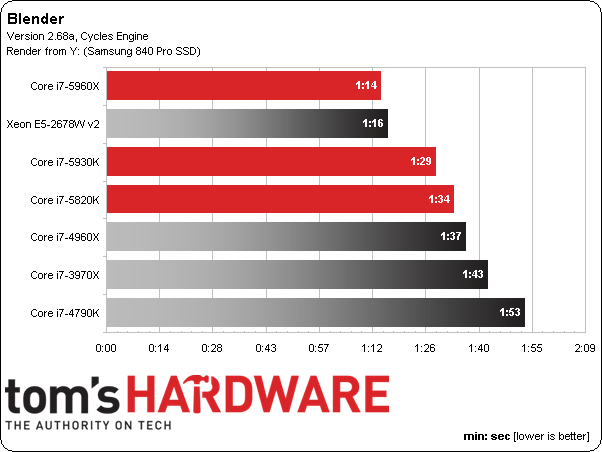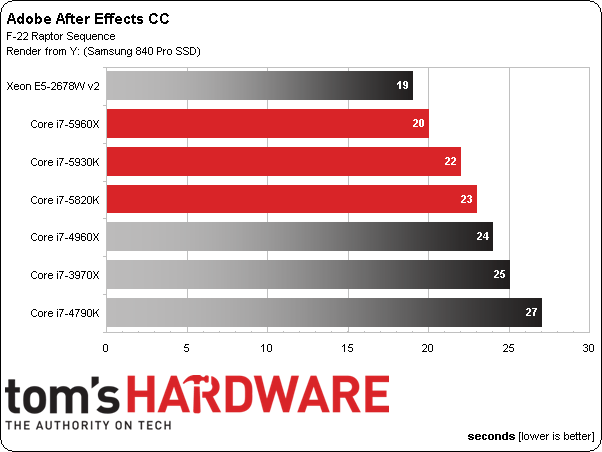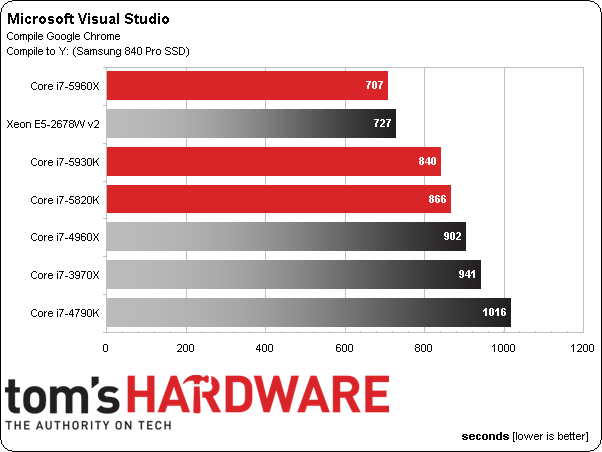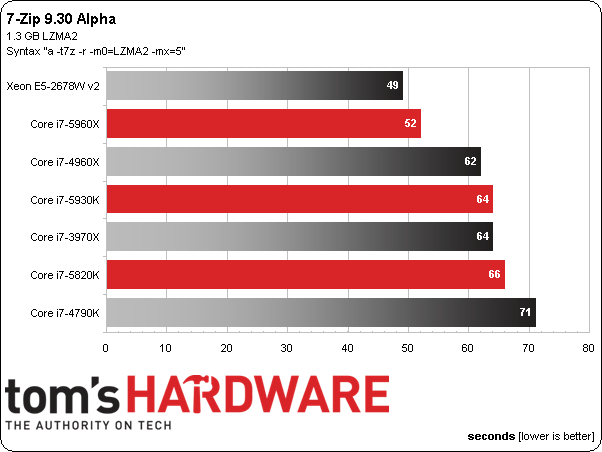Intel Core i7-5960X, -5930K And -5820K CPU Review: Haswell-E Rises
Real-World Benchmarks
Content Creation



To be sure, Haswell-E is all about heavy lifting in content creation applications.
The flagship Core i7-5960X takes second place in our 3ds Max tests, but only because Intel’s Xeon E5-2687W v2 is an eight-core behemoth with a 3.4 GHz base frequency and 4 GHz peak clock rate. That processor sells for $2000—twice the -5960X. Shedding a couple of cores knocks the -5930K into third place, while the -5820K succumbs to Intel’s Core i7-4960X.
Next to all of that heavy metal, a $340 Core i7-4790K looks pretty darned good. There will be those times when a six-core -5820K for a few bucks more is even better, though.
Blender also rewards high core counts. Both eight-core models excel, and Core i7-5960X comes out on top (just barely) thanks to Haswell’s advantages over Ivy Bridge. The two six-core implementations of Haswell-E snag third and fourth place, employing architectural improvements to outpace Ivy Bridge-E and Sandy Bridge-E. The four-core Haswell design can’t keep up.
Sony’s video editing software gets some boost from our GeForce GTX Titan. And as promised on the previous page, folding OpenCL acceleration into the equation throws off our expectations. The outcome falls within a five-second range, but Haswell-E doesn’t start showing up until third place. More than anything, this tells us we’re limited by our GeForce GTX Titan. It’d take a much slower host processor to hurt the render time.
Adobe CC



The scaling in Premiere Pro isn’t as severe as, say, Blender. But the Xeon, with its eight cores and aggressive clock rate, still scores a first-place finish. Our other eight-core chip appears in fourth place, presumably due to its slower 3 GHz base frequency. Stepping up to the -5930K’s 3.5 GHz floor is enough for second place.
After Effects enjoys the Xeon’s tuned frequency, first, and Haswell-E’s efficient architecture, second. The other six-core CPUs pile in ahead of Core i7-4790K, corroborating evidence that this benchmark does benefit from parallelization.
Get Tom's Hardware's best news and in-depth reviews, straight to your inbox.
As you no doubt already know, our Photoshop workload consists of two distinct metrics: one that uses well-threaded filters to tax host processors, and another laced with OpenCL acceleration. The former, in red, demonstrates the benefit of eight-core processors versus six-core models compared to a lone quad-core example. The latter is all over the place. The fact that Core i7-4790K is way in front suggests a few fast cores can feed Nvidia’s GeForce GTX Titan more effectively than wider CPUs operating at lower frequencies.
Productivity and Media Encoding






LAME and iTunes are our two single-threaded tests; both pummel the big eight-core -5960X for its relatively modest peak Turbo Boost bin. Core i7-5930K stretches up to 3.7 GHz, which is good enough for middle-of-the-pack finishes. But the Core i7-4790K hitting 4.4 GHz cannot be matched. Single-threaded software is so last decade, though.
Shifting gears to TotalCode Studio reminds us that the eight-core chips excel under the right conditions. And if you’re in the market for a $1000 CPU, the applications important to you are probably the sort able to benefit from lots of cores…
…like Visual Studio, for example. Haswell-E takes three of the top four positions, interrupted only by the eight-core Xeon built on an Ivy Bridge foundation. If you’re compiling big projects, paying extra for a Core i7-5820K over a Core i7-4790K could save you enough time to justify the premium.
FineReader similarly shows off what an eight-core chip is capable of. The six-core models clump up together, while four cores don’t show as well in our OCR-based test.
HandBrake rounds out a collection of benchmarks capable of utilizing whatever processing resources you offer. The $1000 Core i7-5960X matches the $2000 Xeon, both with eight cores. Haswell’s IPC-oriented advancements help carve out a victory over Ivy Bridge-E and Sandy Bridge-E at six cores. And the Core i7-4790K hangs in there thanks to the same modern architecture and a 4 GHz base clock rate.
Compression



Sorting by our CPU test, WinZip tells a similar story as most of the benchmarks preceding it: eight cores are fastest in a parallelized workload, six cores are also swell, and four execution cores appear quite mainstream.
WinRAR isn’t as damning. Its limited optimizations are more inclined to favor the Core i7-4790K’s high clock rate.
Meanwhile, 7-Zip breaks the tie. More so than we might have guessed at the outset of today’s review, a lower-clocked eight-core processor can flex its muscle in a collection of common software. You don’t necessarily need a specially-written engineering or financial analysis title to realize big gains.
Current page: Real-World Benchmarks
Prev Page Synthetic Benchmarks Next Page Battlefield 4, Grid 2, And Metro: Last Light-
B4vB5 Chris and Igor @ TomsHW,Reply
Bit disappointed to not see a comparison with the Xeon E5-1650v2(or 1660v2), as the 2600 is a bit overkill comparing prices. Some of us just need a workstation with ECC ram and not just a free-for-all(ie someone else is paying) Xeon 2600 fest. -
JamesSneed Out of curiosity why were so many of the gaming tests only done at 2560x1440? Seems like you would be more GPU bound at this resolution. I'm not sure it really matters but I do like gaming at 1080p for the very high frame rates was curious if these would push frame rates higher. Otherwise nice review.Reply -
ohim Reply14063555 said:Affordable 8-cores from Intel are finally coming. Awesome.
1000$ is affordable to you ? :))
14063653 said:Out of curiosity why were so many of the gaming tests only done at 2560x1440? Seems like you would be more GPU bound at this resolution. I'm not sure it really matters but I do like gaming at 1080p for the very high frame rates was curious if these would push frame rates higher. Otherwise nice review.
Though you have a point here, the guy buying such CPUs most likely will game at above 1080p .. but this would have implied using 2 GPUs at least in the test. -
chiefpiggy Why do they call these their "5th generation" of Intel core processors if they're refreshes of the Haswell processors? I get that they have revolutionary technology within but with the release of broadwell so soon I doubt that anyone would buy these processors..Reply -
envy14tpe I need this system to play Minecraft. with that aside, Intel finally has made a jump in i7s value and performance.Reply -
srap "Single-threaded software is so last decade, though."Reply
I have a hunch that we will never see anything like this in the comment sections of AMD reviews. Not sure why :D -
CaptainTom Yeah the real winner of a cpu here is definitely the 5820K. If I were building now, that is what I would use.Reply

